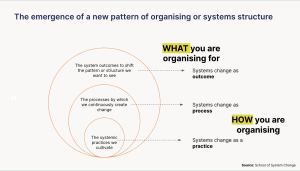The purpose of this blog is not to give you the definitive answer to this question, or to do a full literature review. It is very much where I have got to on my exploration in research and practice. Here I will say what a system is, how they might change — and then defined system change as both an outcome and a process by which we might create change.
Please send me more definitions, examples and framings that you use — we want to collate these part of the School of System Change.
What is a system?
There are many definitions but here is a commonly used version:
A system is ‘a set of things — people, cells, molecules or whatever — interconnected in such a way that they produce their own pattern of behaviour over time’ (Meadows, 2010)
So a system can be ecosystems, such as the marine environment, that also include our social systems such as food systems, they can be socially created systems such as education, or describe a place. They can be small, such as ourselves or large — like the whole economy.
System change a definition
System change is the emergence of a new pattern of organisation or system structure*
System change — as an outcome
What are the new patterns and structures that might emerge? — defining systemic impact
We have found ourselves over the last few years starting to use Meadows leverage points as a way to help us understand, provide indicators and define the system structure or pattern that might change. As you go down the list the greater leverage and therefore impact you might have on changing the system. System change is unlikely to happen in just one of these ways but a combination of them all.
- Structures –changes in the physical structures of a system for example the way a transport, energy system or place is organised
- Flows — changes in how flows of information, finance or how value might be distributed, are configured and relate to each other
- Rules — the rules dictate how the system is organised, so if they change they will have an impact on the flows, patterns and structures of the system
- Power to evolve — this is the one I find the hardest to get my head around. The power to add, change, evolve or self-organise system structure. So can we put in place the ability for the system to change, adapting to different responses to maintain the goal of the system. If a system is self-organising it has the power to keep evolving itself.
- Goal — If the goal of the system, it purpose and function, change, it will ultimately determine how the rest of the system operates.
- Paradigm — A paradigm is a set of assumptions or a view about how the world works, it is a pattern of organising our thoughts, which informs how we act and how structures, flows, rules, goals arise.
How do systems change?
There are different frameworks that describe how systems change that can serve as the basis of strategy and design of system change interventions. Here I just mention two:
Drawing from living systems, and could be represented by the adaptive cycle where structures are going through continual change

In a previous blog I also talk about how living systems change — where interactions, created by innovation, learning can trigger structural changes in the system through feedback loops.
A number of organisations, including our own also draw from Sustainability Transitions Theory.
‘A transition is a radical, structural change of a societal (sub)system that is the result of a co-evolution of economic, cultural, technological, ecological and institutional developments at different scale-levels.’

Other practitioners who have used this theory include Finance Innovation Lab and SMART CSOs
System change — a process
There are other social theories that help organise the type of processes we might use — for example Theory U, used by Prescencing Institute, U-Labs and Reos Partners.

Many organisations used a blending of approaches for example the Natural Step Canada draw on approaches such as Change Labs, Design Thinking, Theory U, the Framework for Strategic Sustainable Development and Collective Impact, so as to to foster deep learning, bold action, and unconventional partnerships and collaboration.
Here are some processes of system change that other organisations use. For the School of System Change we have looked at what the core capabilities that underpin these processes are, these can be found in this blog.
This blog was written in preparation for a session I am facilitating at SIX: Wasan Island Systems Change Retreat
Update, April 2017: The report highlighting the lessons from the retreat can be found here
- (Birney, 2015: 41) Embarrassing self referencing but as my academic self I feel I have to





